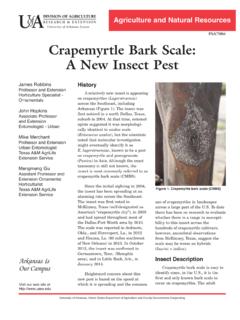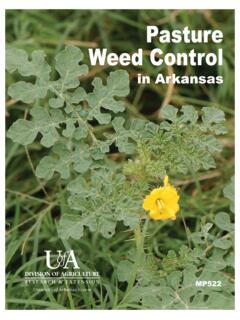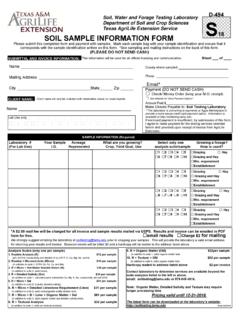Transcription of Test Your Soil for Plant Food and Lime Needs - FSA-2121
1 Agriculture and Natural Resources FSA2121 Test your soil for Plant food and Lime Needs Leo Espinoza Associate Professor, soil Scientist Michael B. Daniels Professor, Water Quality and Nutrient Management Arkansas Is Our Campus Visit our web site at: A soil test An estimate of the supply of Plant food elements in the soil and If the soil is in the correct pH range (too acid or too alkaline). soil test recommendations Plant food needed at planting or green up. Lime needed to offset harmful soil acidity. Before taking soil samples, draw a sketch showing the different fields or areas (Figure 1). Number each field or area. Figure 1 Sample areas around shrubs separately from turf. If you have a large lawn or garden, sample areas separately that have been managed differently or will be managed differently. Sample each field or management unit separately. Use the following procedure: 1.
2 Gently rake aside mulch or surface litter like straw, leaves and old stalks (Figure 2). Figure 2 2. Take soil with a soil probe or shovel from at least 12 samples in each area to obtain a represen tative sample (Figure 3). A zigzag sampling pattern is preferred (Figure 4). Fertilizer and lime recommendations are no better than the sample taken. Figure 3 University of Arkansas, United States Department of Agriculture, and County Governments Cooperating Figure 4 zigzag preferred sampling pattern 3. Sample crop fields to the depth of plowing, usually 6 inches (Figure 5). Take samples in pastures, gardens, lawns, around shrubs and golf courses to a depth of about 4 inches and mature fruit trees at a depth of 12 inches. At each stop, place a small core or strip of soil in a clean bucket or paper bag. Figure 5 4. Mix soil thoroughly. Discard rocks, gravels and roots (Figure 6). Figure 6 5. Allow the soil Figure 7 sample to air dry before filling the sample box (Figure 7).
3 Spread the sample on a clean surface in the open. Spreading newspapers or large paper bags on a countertop or workbench works nicely. Do not heat the sample in an oven to speed drying. 6. Remove one pint for the laboratory sample (Figure 8). Label with the field number or Figure 8 name. Be sure to completely fill the pint container (containers can be obtained from your local Extension office). 7. Take samples to your county Extension agent s office to send to the laboratory. Be prepared to give a short history of each field. A good sample with accurate information will result in a good recommendation. your soil tests can serve as a guide for fertilizer practices for the next three or four years. If you have tests over four years old, take samples again for up to date recommendations. If using intensive management or producing several crops per year, consider sampling yearly. For information on understanding the numbers on your soil test report, ask your county agent for a copy of FSA2118, Understanding the Numbers on your soil Test Report.
4 Also, ask your county agent about the availability of soil probes. Printed by University of Arkansas Cooperative Extension Service Printing Services. DR. LEO ESPINOZA is associate professor, soil scientist, and Issued in furtherance of Cooperative Extension work, Acts of May 8 and DR. MICHAEL B. DANIELS is professor, water quality and nutrient June 30, 1914, in cooperation with the Department of Agriculture, management, University of Arkansas Division of Agriculture, Little Rock. Director, Cooperative Extension Service, University of Arkansas. The Arkansas Cooperative Extension Service offers its programs to all eligible persons regardless of race, color, national origin, religion, gender, age, disability, marital or veteran status, or any other legally protected status, FSA2121 PD 6 09RV and is an Affirmative Action/Equal Opportunity Employer.

















